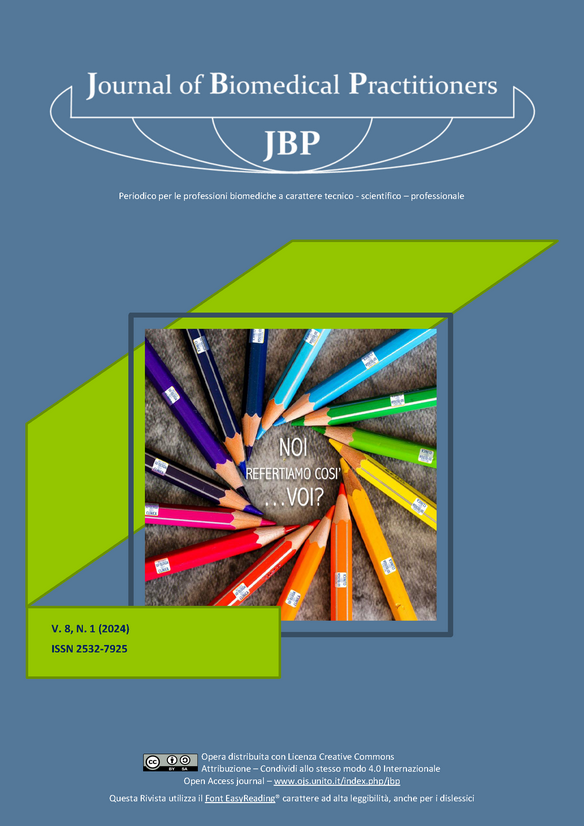Intervento preventivo e terapeutico nell’osteoartrosi degli arti inferiori: revisione sistematica della letteratura.
Contenuto principale dell'articolo
Abstract
Introduzione e obiettivo
L’osteoartrosi (OA) è caratterizzata dalla degenerazione della cartilagine che provoca il cedimento strutturale e funzionale delle articolazioni sinoviali, principalmente attraverso un’alterazione regressiva e non infiammatoria della cartilagine. Questa patologia è una delle principali cause di disabilità in tutto il mondo, in gran parte a causa del dolore. L’obiettivo di questo studio è eseguire una revisione sistematica confrontando l’efficacia delle varie terapie riabilitative proposte per questa patologia, studiare l’importanza della prevenzione in soggetti maggiormente esposti ed evidenziare gli interventi di trattamento che apportano maggiori risultati al paziente.
Materiali e metodi
La ricerca della letteratura, condotta seguendo le linee guida internazionali PRISMA mediante la strategia PICO, è stata effettuata attraverso le banche dati Medline (via PubMed), Scopus, PEDro, LILACS e Trip Databse tra i mesi di Maggio e Giugno 2023. La letteratura presente è stata vagliata mediante la formulazione di diverse stringhe di ricerca: PubMed ((“Osteoarthrosis” [MeSH]) AND (“physiotherapy” [MeSH] OR (“rehabilitation” [MeSH] OR (“exercise” [MeSH])), Scopus, LILACS e Trip Database (“Osteoarthrosis” AND (“physiotherapy” OR “rehabilitation” OR “ exercise”)) e su PEDro è stata utilizzata la stringa “Osteoarthrosis AND Rehabilitation”. Sono stati inclusi solo studi RCT in lingua inglese, pubblicati dal 2013 al 2023 che andassero a prendere in esame l’arto inferiore con un range di età da 55 a 70 anni non operati. Gli articoli duplicati sono stati eliminati mediante il software EndNote. Inizialmente sono stati selezionati gli articoli pertinenti in base al titolo, poi in base alla lettura dell’abstract e infine in base alla lettura del full text.
Risultati
Dopo l’inclusione sono stati selezionati 6 RCT con una popolazione affetta da osteoartrosi degli arti inferiori. E’ stata valutata la qualità metodologica mediante la scala PEDro. Gli studi inclusi presentano mediamente un punteggio di 7.3. Sono emerse multiple strategie di trattamento: allenamento aerobico, esercizi di stretching dei muscoli dell’anca, esercizi di equilibrio statico e dinamico, esercizi di stabilità e resistenza, elettroterapia, ma è emerso che la maggior parte degli studi inclusi predilige l’esercizio di rinforzo muscolare.
Discussione e conclusioni
Alla luce dei risultati ottenuti da questa Revisione Sistematica, si ritiene necessario riconoscere gli interventi riabilitativi, attraverso la loro dimensione multidisciplinare, parte fondamentale del trattamento, importanti tanto quanto l’intervento farmacologico, per determinare un rallentamento nella progressione della patologia e un efficace controllo di quest’ultima.
L’analisi di questi ultimi ci porta ad affermare che sarebbe necessario ampliare la ricerca tramite follow-up a lungo termine e aumentare la grandezza del campione.
Downloads
Dettagli dell'articolo
Gli autori mantengono i diritti sulla loro opera e cedono alla rivista il diritto di prima pubblicazione dell'opera, contemporaneamente licenziata sotto una Licenza Creative Commons - Attribuzione che permette ad altri di condividere l'opera indicando la paternità intellettuale e la prima pubblicazione su questa rivista.
Riferimenti bibliografici
[2] F. Postacchini, E. Ippolito, A. Ferretti, Ortopedia e Traumatologia quarta edizione. Antonio Delfino Editore, 2022.
[3] T. E. McAlindon, C. Cooper, J. R. Kirwan, e P. A. Dieppe, «Determinants of disability in osteoarthritis of the knee.», Ann. Rheum. Dis., vol. 52, fasc. 4, pp. 258–262, apr. 1993, doi: 10.1136/ard.52.4.258.
[4] G. Iolascon et al., «Early osteoarthritis: How to define, diagnose, and manage. A systematic review», Eur. Ge-riatr. Med., vol. 8, fasc. 5, pp. 383–396, nov. 2017, doi: 10.1016/j.eurger.2017.07.008.
[5] V. L. Johnson e D. J. Hunter, «The epidemiology of osteoarthritis», Best Pract. Res. Clin. Rheumatol., vol. 28, fasc. 1, pp. 5–15, feb. 2014, doi: 10.1016/j.berh.2014.01.004.
[6] «Montecucco - Conti - Caporali - Cutolo - Doria - AAVV Unireuma - Reumatologia . Per Studenti e Medici di Me-dicina Generale Idelson - Gnocchi». Consultato: 29 dicembre 2023. [Online]. Disponibile su: https://www.libreriauniverso.it/
[7] S. Bierma-Zeinstra, M. van Middelkoop, J. Runhaar, e D. Schiphof, «Nonpharmacological and nonsurgical approa-ches in OA», Best Pract. Res. Clin. Rheumatol., vol. 34, fasc. 2, p. 101564, apr. 2020, doi: 10.1016/j.berh.2020.101564.
[8] I. Ilinca, E. Rosulescu, M. Zavaleanu, e L. Constantinescu, «Exercise Therapy Program in Rehabilitation of Pa-tients with Primary Hip Osteoarthritis».
[9] R. R. Bannuru et al., «OARSI guidelines for the non-surgical management of knee, hip, and polyarticular osteoar-thritis», Osteoarthritis Cartilage, vol. 27, fasc. 11, pp. 1578–1589, nov. 2019, doi: 10.1016/j.joca.2019.06.011.
[10] E. Benli Küçük, Ö. Özyemişci Taşkıran, N. Tokgöz, e J. Meray, «Effects of isokinetic, isometric, and aerobic exercises on clinical variables and knee cartilage volume using magnetic resonance imaging in patients with osteoarthritis», Turk. J. Phys. Med. Rehabil., vol. 64, fasc. 1, pp. 8–16, giu. 2017, doi: 10.5606/tftrd.2018.795.
[11] Kholvadia, Aayesha, Demitri Constantinou e PJ-L. Gradidge, «Esplorare l’efficacia della terapia laser di basso li-vello e dell’esercizio fisico per l’artrosi del ginocchio», vol. Giornale sudafricano di medicina dello sport 31.1, 2019.
[12] F. Hakimi, M. Asheghan, e S. E. Hashemi, «Isometric exercise, acupuncture, and magnet therapy for knee osteoarthritis: randomized clinical trial», Rehabil. Med., vol. 23, fasc. 3, pp. 12–20, ago. 2019, doi: 10.5604/01.3001.0013.3766.
[13] P. P. Alfredo et al., «Long-term results of a randomized, controlled, double-blind study of low-level laser the-rapy before exercises in knee osteoarthritis: laser and exercises in knee osteoarthritis», Clin. Rehabil., vol. 32, fasc. 2, pp. 173–178, feb. 2018, doi: 10.1177/0269215517723162.
[14] Gezginaslan, Ömer, et al, «Effetti del rafforzamento del muscolo isocinetico sull’equilibrio, la propriocezione e la funzione fisica nei pazienti con osteoartrite bilaterale del ginocchio con moderato rischio di caduta», vol. Gior-nale turco di medicina fisica e riabilitazione 64.4, 2018.
[15] P. Sinatti, E. A. Sánchez Romero, O. Martínez-Pozas, e J. H. Villafañe, «Effects of Patient Education on Pain and Function and Its Impact on Conservative Treatment in Elderly Patients with Pain Related to Hip and Knee Osteoar-thritis: A Systematic Review», Int. J. Environ. Res. Public. Health, vol. 19, fasc. 10, p. 6194, mag. 2022, doi: 10.3390/ijerph19106194.
[16] J. W.-P. Michael, K. U. Schlüter-Brust, e P. Eysel, «The Epidemiology, Etiology, Diagnosis, and Treatment of Osteoarthritis of the Knee», Dtsch. Ärztebl. Int., mar. 2010, doi: 10.3238/arztebl.2010.0152.
[17] W. B. Lim e O. Al-Dadah, «Conservative treatment of knee osteoarthritis: A review of the literature», World J. Orthop., vol. 13, fasc. 3, pp. 212–229, mar. 2022, doi: 10.5312/wjo.v13.i3.212.

